Hot Stuff: High Heat Can Damage Natural Stone
Karin Kirk
Courtesy MB Stone
Diagrams and photos ® Karin Kirk.
Many types of natural stone form in hot environments. Granite comes from molten magma that’s 1,000 to 2,000 degrees Fahrenheit, and marble is the beautiful result of limestone that is compressed and heated to somewhere between 600 and 1,500 degrees.
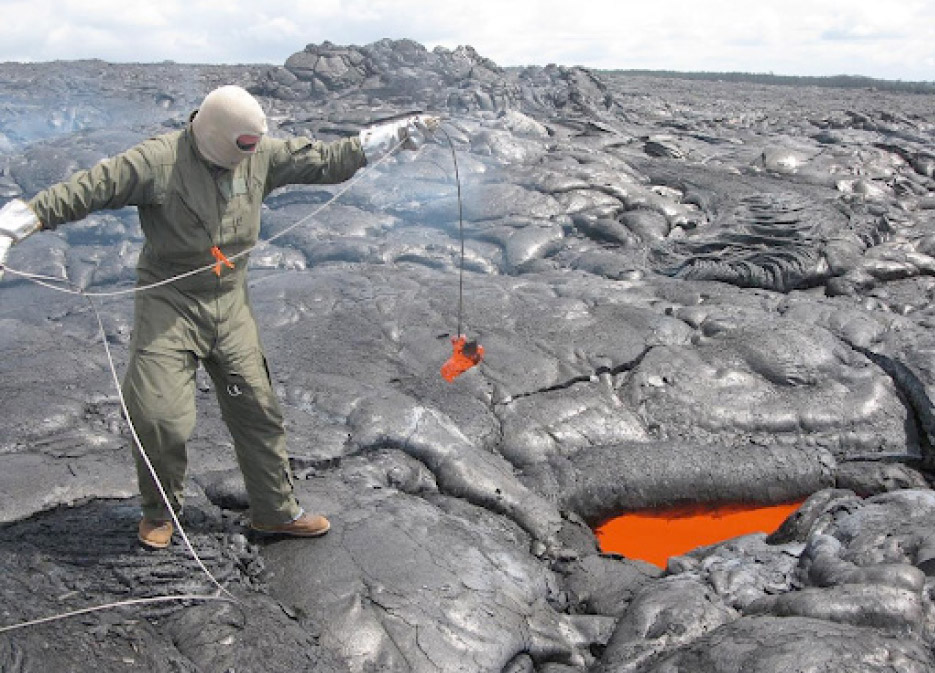
Clearly that must mean these stones can withstand heat, right? A hot casserole pan is no match for a subterranean magma chamber, after all. But unfortunately, this is one of those cases where one’s intuition turns out to be false. Although granite starts to melt around 1,100 degrees, it can be damaged at temperatures much lower than that. Some stones can start to show mild effects of heat damage when exposed to temperatures around 400 degrees for an hour or more.
There are four ways that heat can damage even the toughest granites: The minerals can undergo physical changes, the stone can become more porous, the sealer can react to the heat, and the slab can crack. We’ll set aside the last one for another time and focus on the first three.
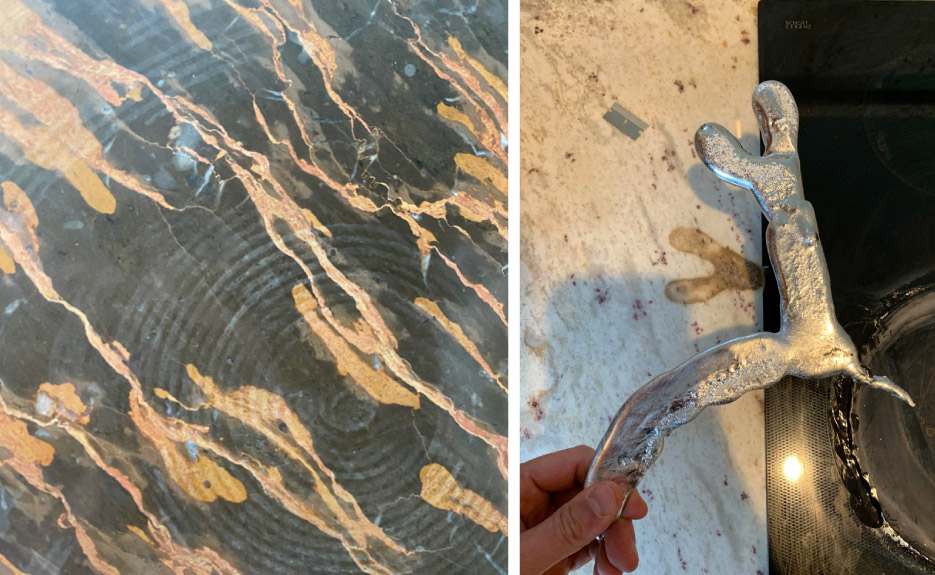 |
|
A hot pan left this crisp pattern and vivid discoloration on Portoro Marble. |
Destroying Stone in the Name of Science
Geologists love rocks, but that doesn’t stop us from subjecting them to all manner of terrible conditions to see what happens.
As a result, there’s an entire body of research devoted to the ways that heat can damage granite, marble, and other stones. Much of this work is in reference to buildings and monuments damaged by fire, but the experiments are totally relevant to less-disastrous events too.
A key takeaway from the research is this: “Granite submitted to high temperatures may lead to the loss of aesthetic values even before structural damage is caused.” (Vazquez et al., 2016)
In other words, just because the stone didn’t get hot enough to melt or crack, doesn’t mean it won’t start to change appearance.
One particularly useful study took 13 types of sawn, unpolished, unsealed commercial granites, put them in a furnace at increasingly hot temperatures, then measured the effects. An important difference between experiments on rocks and a real-world kitchen “incident” is that in the experiments, stones were exposed to high heat for an hour or more. In the kitchen, it’s likely that the heat exposure would be only a matter of minutes.
But on the flip side, the experiments gradually raised the stone’s temperature, whereas in the kitchen the stone could be heated rapidly, which can be more damaging. Nevertheless, the experiments offer useful insight on what can happen to various stones when heated.
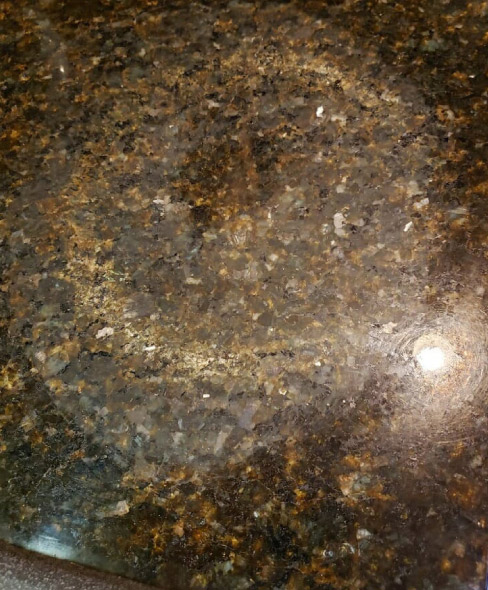 |
|
Note the roughened, dulled surface of Uba Tuba after heat exposure.
|
Heat Can Make Stone Redder, Yellower, Lighter, or Darker
Many types of stone change color when exposed to high heat. In experiments, several of the stone samples started to show color changes after spending 3 hours at temperatures as low as 400 degrees, but the effects were subtle. At temperatures hotter than that, changes in color became increasingly apparent.
The most common change was a shift toward a redder overall color. The fancy name for this is ‘rubefaction,’ which is just a highbrow way of saying something turns red. The reddening is caused by oxidation of iron within the minerals. In some cases, green mica (chlorite) turned yellow, and some dark, mica-rich granites also turned yellow.
In experiments on four types of labradorite, a type of black granite, three of the sample stones started to lighten when exposed to heat. In one sample, the heat made the stone darker. In either case, the effects from exposure to 400 degrees were barely noticeable. But by 500 degrees or more, changes were more pronounced.
Heat Can Make the Surface of a Stone More Rough
Stone industry pros have reported that stones exposed to heat can lose their polished luster. That observation is backed up by experimental results, and it’s a property geologists call ‘roughness.’ As the stone heats up, the tiny spaces in between each grain can start to expand, forming microscopic cracks and an uneven surface. This is particularly evident in mica-rich stones, because mica is made up of thin sheets that are only loosely attached to each other in the first place.
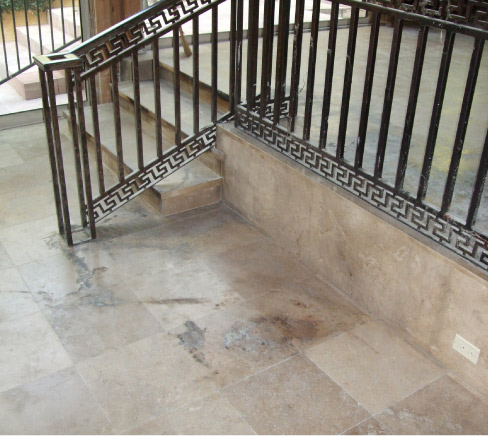 |
|
Fire damage on limestone. Stones with low porosity are especially susceptible to damage from heat.
|
Fine-grained granites are much more likely to develop a rough surface than those with large grains. A fine-grained, mica-rich granite is the most vulnerable to developing a roughened surface when heated, and experiments showed effects beginning at around 400 degrees.
When stones were exposed to ever-hotter temperatures (way beyond what could happen in a kitchen), the micro-cracks became major cracks, and some minerals became detached from the rest of the rock. Some samples lost all of their structural integrity and literally turned into a handful of gravel. Note that this occurred at 1,800 degrees, so rest assured, that’s not something that could happen by putting even a flaming hot skillet on the countertop.
Heat Increases a Stone’s Porosity
When heat stress causes micro-cracks in stone, the stone becomes more porous. This is a one-way street; cooling the stone does not return the stone to its original porosity. Stones that had low porosity to begin with are especially prone to becoming more porous when damaged by heat. This same effect occurs in limestone and marble, too, beginning at temperatures above 400 degrees.
Sealers Can Become Scorched from Heat
Sealers can be a wildcard when it comes to heat damage.
For starters, a sealer will not protect a stone from heat damage. In fact, a sealer can make things worse because of the potential for chemical reactions in the sealer. This aspect of heat damage has not been studied experimentally (that I know of), so it’s hard to pin down the exact effects that a sealer can have when exposed to high heat. It’s also hard to distinguish whether a heat-affected stone was damaged by the sealer, or simply by the effects of the heat on the stone itself.
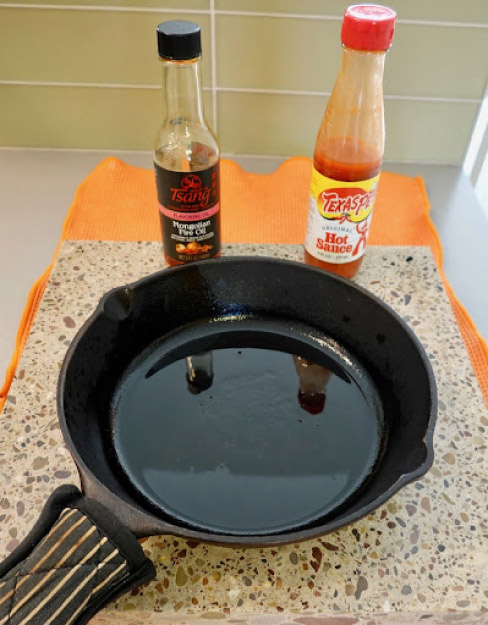 |
|
The synergy of heat plus “spilled” oil on a countertop caused more damage than either one alone. This test replicates some of the unforeseen events that can happen in a real-world kitchen.
|
Kitchen Experiments
In a detailed study for the Natural Stone Institute, I subjected sealed granite, engineered quartz, concrete, and sintered ceramic to a battery of tests. The most reliable way to damage the slabs was to place a 570-degree skillet on a slab that had oily substances, such as chili oil, on it. The hot skillet heated the oil and managed to stain or discolor most of the materials in the test. The synergy of heat plus oil caused more damage than either one alone, and this test replicates some of the unforeseen events that can happen in a real-world kitchen. In fact, this scenario isn’t even particularly unlikely, since it’s common for cooking pans to develop grease buildup on the bottom.
Is it Fixable?
Damage from heat is permanent. Discoloration and changes in texture may run several millimeters deep into the stone, so grinding it away is likely to leave an uneven surface. Re-polishing the surface may be successful in restoring the luster, and may diminish the look of color or textural changes triggered by heat. Ultimately, it depends on how noticeable the damage is in the first place.
The Bottom Line? Trivets.
It would be nice if some magical treatment existed that could roll back the physical changes in a stone when exposed to high heat. Alas, like many of life’s disappointments, this problem can’t be reversed. The best thing to do is use trivets for hot pans, particularly those that are hotter than 400 degrees.
Natural stone is not unique in its dislike for hot temperatures; the vast majority of countertop surfaces cannot withstand a scorching hot pan - soapstone being a notable exception. Engineered quartz, butcher block, and laminates will all be damaged by heat. The upshot is that most of us are well-trained to keep hot pots off the countertop, and this is a smart practice that we’d be well-advised to continue.
Karin Kirk is a geologist and science educator with over 20 years of experience and brings a different perspective to the stone industry. Karin is a regular contributor to usenaturalstone.org and the Slippery Rock Gazette. Contact her at karinkirk@gmail.com .